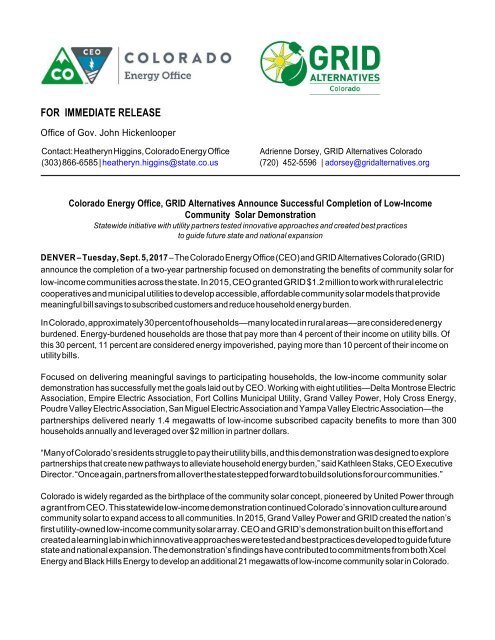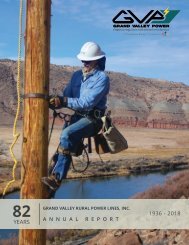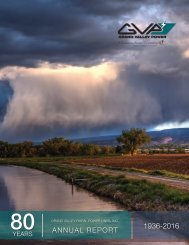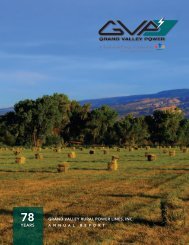GRID Alternatives_GVP_CEO capstone event
You also want an ePaper? Increase the reach of your titles
YUMPU automatically turns print PDFs into web optimized ePapers that Google loves.
FOR IMMEDIATE RELEASE<br />
Office of Gov. John Hickenlooper<br />
Contact: Heatheryn Higgins, Colorado Energy Office Adrienne Dorsey, <strong>GRID</strong> <strong>Alternatives</strong> Colorado<br />
(303) 866‐6585 | heatheryn.higgins@state.co.us (720) 452‐5596 | adorsey@gridalternatives.org<br />
Colorado Energy Office, <strong>GRID</strong> <strong>Alternatives</strong> Announce Successful Completion of Low‐Income<br />
Community Solar Demonstration<br />
Statewide initiative with utility partners tested innovative approaches and created best practices<br />
to guide future state and national expansion<br />
DENVER – Tuesday, Sept. 5, 2017 – The Colorado Energy Office (<strong>CEO</strong>) and <strong>GRID</strong> <strong>Alternatives</strong> Colorado (<strong>GRID</strong>)<br />
announce the completion of a two‐year partnership focused on demonstrating the benefits of community solar for<br />
low‐income communities across the state. In 2015, <strong>CEO</strong> granted <strong>GRID</strong> $1.2 million to work with rural electric<br />
cooperatives and municipal utilities to develop accessible, affordable community solar models that provide<br />
meaningful bill savings to subscribed customers and reduce household energy burden.<br />
In Colorado, approximately 30 percent of households—many located in rural areas—are considered energy<br />
burdened. Energy‐burdened households are those that pay more than 4 percent of their income on utility bills. Of<br />
this 30 percent, 11 percent are considered energy impoverished, paying more than 10 percent of their income on<br />
utility bills.<br />
Focused on delivering meaningful savings to participating households, the low‐income community solar<br />
demonstration has successfully met the goals laid out by <strong>CEO</strong>. Working with eight utilities—Delta Montrose Electric<br />
Association, Empire Electric Association, Fort Collins Municipal Utility, Grand Valley Power, Holy Cross Energy,<br />
Poudre Valley Electric Association, San Miguel Electric Association and Yampa Valley Electric Association—the<br />
partnerships delivered nearly 1.4 megawatts of low‐income subscribed capacity benefits to more than 300<br />
households annually and leveraged over $2 million in partner dollars.<br />
“Many of Colorado’s residents struggle to pay their utility bills, and this demonstration was designed to explore<br />
partnerships that create new pathways to alleviate household energy burden,” said Kathleen Staks, <strong>CEO</strong> Executive<br />
Director. “Once again, partners from all over the state stepped forward to build solutions for our communities.”<br />
Colorado is widely regarded as the birthplace of the community solar concept, pioneered by United Power through<br />
a grant from <strong>CEO</strong>. This statewide low‐income demonstration continued Colorado’s innovation culture around<br />
community solar to expand access to all communities. In 2015, Grand Valley Power and <strong>GRID</strong> created the nation’s<br />
first utility‐owned low‐income community solar array. <strong>CEO</strong> and <strong>GRID</strong>’s demonstration built on this effort and<br />
created a learning lab in which innovative approaches were tested and best practices developed to guide future<br />
state and national expansion. The demonstration’s findings have contributed to commitments from both Xcel<br />
Energy and Black Hills Energy to develop an additional 21 megawatts of low‐income community solar in Colorado.
As project implementer for the demonstration, <strong>GRID</strong> partnered with utilities to develop appropriate product<br />
offerings, construct systems, conduct customer outreach, engage project volunteers and provide job training. The<br />
projects selected were both affordable and scalable for utility partners with potential to expand across the state.<br />
“In working with a variety of utilities, we’ve been able to develop a flexible model for low‐income community solar<br />
that can be used anywhere,” said Chuck Watkins, Executive Director of <strong>GRID</strong> <strong>Alternatives</strong> Colorado. “The<br />
investment from <strong>CEO</strong> has been a win for utilities and their stakeholders, a win for energy‐burdened households,<br />
and a win for solar access nationally.”<br />
“The transformative impact in partnering with <strong>GRID</strong> <strong>Alternatives</strong> to build the country’s first utility‐owned<br />
community solar project dedicated to low‐income members not only helps our local communities in Colorado, it<br />
also forges a path for other communities across the nation,” said Tom Walch, Chief Executive Officer of Grand<br />
Valley Power. “The concept of serving members who would otherwise not be able to participate based on a number<br />
of limitations has been removed with this model.”<br />
<strong>CEO</strong> and <strong>GRID</strong>’s demonstration has laid the groundwork for expansion of low‐income solar development across the<br />
country. Based on Colorado’s pioneering work, several states have already announced upcoming projects and many<br />
others are in development stages of similar programs.<br />
“Colorado has proven once again to be an innovator in delivering collaborative solutions to challenging energy<br />
problems,” continued Staks. “This demonstration shows that solutions are out there to lower energy costs, reduce<br />
carbon emissions and diversify our energy portfolio.”<br />
A comprehensive evaluation of the demonstration including history, policy agenda and implications, project details<br />
and customer benefits will be available from <strong>CEO</strong> in the winter of 2017.<br />
<strong>CEO</strong>, <strong>GRID</strong> and <strong>GVP</strong> will host a community <strong>event</strong> on Thursday, Sept. 7, to celebrate the completion of the eight<br />
utility projects and conclusion of the demonstration. The <strong>event</strong> will begin at 11 a.m. at 714 29 Road in Grand<br />
Junction.<br />
###<br />
About Colorado Energy Office<br />
The Colorado Energy Office works to deliver cost‐effective energy services and advance innovative energy solutions<br />
for the benefit of all Coloradans. Go to colorado.gov/energyoffice to learn more.<br />
About <strong>GRID</strong> <strong>Alternatives</strong><br />
<strong>GRID</strong> <strong>Alternatives</strong> Colorado is an affiliate of <strong>GRID</strong> <strong>Alternatives</strong>, the nation’s largest nonprofit solar installer, bringing<br />
clean energy technology and job training to low‐income families and underserved communities through a network<br />
of community partners, volunteers and philanthropic supporters. For more information, visit<br />
gridalternatives.org/colorado.<br />
About Grand Valley Power<br />
Formed in 1936, Grand Valley Power was the first rural electric cooperative organized in Colorado. Serving over<br />
17,000 customers within the Grand Valley, Plateau Valley and Mesa County area, Grand Valley Power is dedicated<br />
to empowering lives with hometown service. See http://www.gvp.org for more details.

















